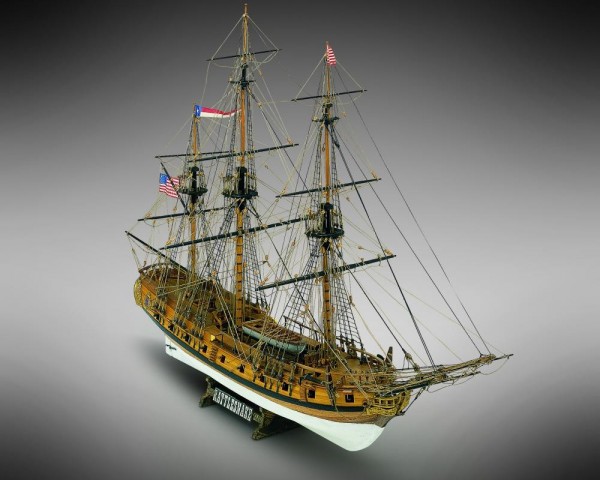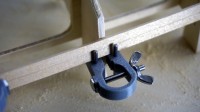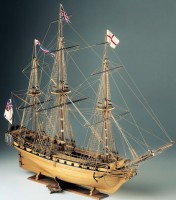- Order number: 21736
- Hersteller: Mamoli
- Zustand: Neuer Artikel
Corvette Rattlesnake, a ship model kit from the manufacturer Mamoli
History of the original
The corvette Rattlesnake was built around 1780 on the American east coast, according to most sources in Plymouth, Massachusetts. Its design consistently met the requirements of privateering in the Atlantic: high hull speed in fresh to strong winds, low wetted surface area, sharp stem, finely tapered stern with moderate transom width, shallow draught for coastal waters, yet sufficient form stability for cross seas. It was built using the classic frame and plank construction method from oak and pine, with stronger floor timbers in the area of the mast bases and a strong oak keel. The deck planking was tight, with regular caulking joints made of tar and oakum. The main deck had clearly structured gun positions and a low, smooth bulwark without excessive superstructures to minimise the weight above and reduce the windage.
The lines showed the transition from the older, fuller hulls to the later, more distinctive, elongated fast sailors. A long waterline in relation to the overall length, a narrow maximum beam and a relatively flat underwater hull resulted in early planing in the old terminology, but in fact a noticeable reduction in the wave-forming components of the resistance. The sharp bow with a fine angle of entry reduced pitching and spray, which, together with a dry forecastle, significantly improved the operational capability of the forward guns when sailing into the wind. The rudder system remained compact; the blade was steep to ensure sufficient flow at high speeds without making the steering forces excessively heavy.
The rigging followed the practice of fast sloops-of-war and privateers of those years. Three masts with full ship rigging were by no means unusual for American privateers; configurations as heavily rigged two-masted ships with main and foremasts, each with a full set of square sails and additional headsails on the bowsprit, are also documented. Flexible sail handling was essential: large yards for running downwind, high staysail headsails for close-hauled sailing and a finely graded reefing system that allowed the Rattlesnake to accelerate in a controlled manner under changing pressure conditions. Light spars, carefully trimmed shrouds and stiffly run stays gave the rig structural stability without making the ship top-heavy. Hemp rope, tarred and tightly covered, limited friction and stretch, which shortened the trimming work during manoeuvres.
Depending on the equipment situation, the armament comprised 14 to 20 short 6-pounders on wooden cart mounts, supplemented by swivel guns at the ends of the railings for enfilade fire at close range. The firing plan favoured rapid, precise volleys at medium range over broadside, followed by course changes that stole the wind from the enemy. The weapon layout reflected the intended use: stopping merchant ships, outmanoeuvring combat-capable escort ships through agility and acceleration, and rendering prizes incapable of combat through rig-damaging hits. The ammunition chamber was located low and amidships; powder and grenade bags were kept short to maintain a high rate of fire.
The crew consisted of about 85 to 100 men, including an experienced helmsman, navigator, sailmaker, carpenter, armourer and a reinforced boarding party. The service regulations aimed at rapid watch changes and redundant distribution of responsibilities: more than a dozen men could reef simultaneously in combat situations, while a second team operated the guns and a third team carried out damage control. Navigation was based on a quadrant or sextant, a reliable chronometer, log, bearing compass and skilled dead reckoning. The chart sets covered the American east coast, the Banks, the Azores routes and the western approaches to the English Channel; frequent areas of privateering were along busy shipping routes between the West Indies, the British Isles and the North Sea approaches.
The operational history began with privateering voyages under the American flag. The mission was to disrupt British supply lines, bring prizes safely to friendly ports and carry out courier and reconnaissance tasks. The Rattlesnake made several captures in a short period of time, confirming its suitability as a fast, manoeuvrable vessel. Its operational pattern followed a recurring pattern: cruising in busy sea areas under reduced sail, short, powerful approaches under full sail, opening fire with crossfire on the enemy's rigging, manoeuvring to windward, overshooting the bow line, renewing the attack or breaking off depending on the situation.
In June 1781, the American phase ended when the ship was captured by a British frigate. The Royal Navy transferred the ship to England, documented its lines and took the former privateer corvette into its own service. British records highlight the ship's exceptional cruising performance for such a small vessel, the clean flow of water around the bow and the low lateral forces during fast jibes. Under the British flag, the Rattlesnake was given an armament and rig configuration adapted to Royal Navy practice, partly with modified yard heights, reinforced shrouds and a standardised gun armament to keep supplies and ammunition compatible throughout the fleet.
The surviving plans secure its place in the shipbuilding typology of the late 18th century. The preserved drawings show a hull with a long keel line, shallow frame bay and slender stern. The position of the masts emphasises the forward section, which makes the headsails effective and keeps the ship neutral to slightly windward. The frame development demonstrates the economy of the structure: light superstructure, solidly dimensioned midship frame area, targeted material reinforcement around mast heads, chain plates and crane beams. This combination of minimal mass at the top and sufficient rigidity in the substructure explains the lively but controllable pitching and rolling characteristics.
The ship provides numerous striking details for model builders to replicate. The figurehead remains slender, with a long bowsprit whose crane beam and jib boom are neatly secured. The bulwark is low, with clear gunports and simple, functional crane beams. The planking shows regular frame spacing; the nailing is most clearly visible in the strakes. The gun carriages have side handspakes, and the rigging of the return and brake blocks is logical and space-saving. The rig is made of tarred hemp, the blocks appear slim and functional, and the stays run with clean load relief to the cleats. The authentic colour scheme is based on dark, tarred superstructures, natural or oiled wood on the deck, muted colours for decorative trim and a restrained, functional overall appearance; yellow decorative stripes and standardised colour schemes are documented under the British flag.
The Rattlesnake's doctrine of engagement combined speed with tactical versatility. Against opponents of equal size, it relied on course selection and distance control; against larger units, it relied on visual cover, course changes and the use of local weather advantages. Its greatest strength lay in its operational speed: rapid sail changes, short reaction times at the helm, precise trimming of the headsails and disciplined fire exchange. These characteristics made it a suitable tool for asymmetric naval warfare, in which the impact on the enemy's trade, communication routes and morale was given greater weight than line-against-line combat.
After several years in British service, all traces of her are lost in the routine records of demobilisation. For historical purposes, it suffices to say that the Rattlesnake is considered a prototypical example of an American fast sailing ship of the Revolutionary War era. Her lines influenced subsequent light warships and merchant vessels, whose development towards the end of the century culminated in the elegant, very fast schooner and clipper designs. All in all, the Rattlesnake stands for the combination of sober material selection, precise weight distribution, taut rigging and clear operational purpose. Its surviving plans, contemporary descriptions and model implementations show a ship that fulfilled its role with efficiency and visibly advanced the shipbuilding practice of its time.
Kit description
The kit contains all the parts necessary to build the model. The keel and frames are precision laser cut. All the wood and strips for the double planking are selected by hand. Some components are laser engraved for more attractive details. The fittings and the lifeboat are made of simple cast metal. Rigging material and flags are included in the kit. Materials for a model stand and nameplate are also included. A set of sails is not included. Large construction plans and multilingual instructions guide you safely through the entire construction process.
Who is this kit suitable for?
The kit is only suitable for model builders with extensive experience in ship model building.
What else is needed?
Paints, adhesives and tools are required and can be found in our product range.
What do the building instructions look like?
The kit contains 9 very large plans with clear instructions in text, instructions and drawings. There is also a detailed parts list. A German translation is included. The kit has been revised and significantly improved, but the parts lists in the instructions are not yet up to date.
The booklet also contains instructions in English, Italian and French.
Instructions are not available for download.
Technical data:
Scale: 1:64
Length: 697 mm
Height: 436 mm
| Material Hull: | Holz |
| Difficulty: | medium |
| Scale: | M 1:64 |
| Höhe: | 697mm |
| Länge: | 463mm |
Ing. Daniel Dusek
Bratri Hlavicu 117
755 01 Vsetin
Tschechische Republik
dusekinfo@seznam.cz
- Kein Spielzeug
- Nicht geeignet für Kinder unter 14 Jahre
- Enthält verschluckbare Kleinteile















































































